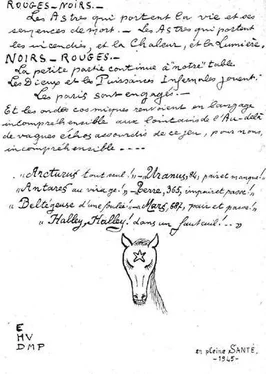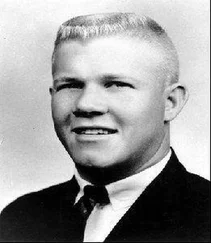28 “three garbage cans” Le Petit Parisien , March 15, 1944.
29 “It’s not an autopsy” Massu, L’enquête Petiot , 79.
CHAPTER 6. THE WOMAN WITH THE YELLOW SUITCASE
1 “I realized” Simone de Beauvoir, The Prime of Life , translated by Peter Green (London: Penguin Books, 1988), 13.
2 Sartre’s friend Jean Paulhan joked Annie Cohen-Solal, Sartre: A Life , translated by Anna Cancogni (New York, Pantheon Books, 1987), 187.
3 “the strongest heterosexual” Ronald Aronson, Camus & Sartre: The Story of a Friendship and the Quarrel That Ended It (Chicago: The University of Chicago Press, 2004), 20.
4 “We were like” Ibid.
5 “Imagine what she” Olivier Todd, Camus: A Life , translated by Benjamin Ivry (New York, Alfred A. Knopf, 1997), 231.
6 “He has no right” French police report printed in Pascal Bonafoux, “Picasso, Français?”: Questions sur la naturalisation de l’artiste , in Bruno Fuligni, ed., Dans les secrets de la police: quatre siècles d’histoire, de crimes et de faits divers dans les archives de la Préfecture de police (Paris: L’Iconoclaste, 2008), 230–231. See also Pablo Picasso: dossiers de la préfecture de police, 1901–1940 by Pierre Daix and Armand Israël (Moudon, Switzerland: Editions Acatos, 2003).
7 “Very illegally” Maurice Toesca, Cinq ans de patience 1939–1944 (Paris: É. Paul, 1975), 179.
8 stacks of manuscripts Gerhard Heller, Un allemand à Paris 1940–1944 (Paris: Éditions du Seuil, 1981), 26–28.
9 heart beating with excitement Ibid., 117–118, his first visit to Picasso, June 1942.
10 the drab palette Pierre Cabanne, Pablo Picasso: His Life and Times (New York: William Morrow and Company, Inc., 1977), 343.
11 a roadside restaurant Georges Massu, L’enquête Petiot: La plus grande affaire criminelle du siècle (Paris: Librairie Arthème Fayard, 1959), 87; time and placement of the stop in police report, March 14, 1944, APP, Série J, affaire Petiot, carton n° I.
12 “roasted barley” Massu, L’enquête Petiot , 88.
13 Maurice Petiot was not there He is invariably placed in the shop, but the Brigade Criminelle report indicates he was not, March 14, 1944, APP, Série J, affaire Petiot, carton n° I. Other reports, along with interviews with Maurice cited below, confirm the fact.
14 thirty-one-year-old Monique would turn thirty-one in nine days.
15 “the most extraordinary” Le Matin , March 23, 1944.
16 Albert Neuhausen Report April 6, 1944, APP, Série J, affaire Petiot, carton n° I.
17 “We spoke of things” Report, March 13, 1944; APP, Série J, affaire Petiot, carton n° I.
18 a black skirt Paris-Matin , March 15, 1944.
19 a few locks Le Petit Parisien , March 16, 1944.
20 before collapsing Massu, L’enquête Petiot , 90–91.
21 One young man Ibid. Le Matin , March 15, 1944.
22 Maurice, who had been apprehended Report, March 24, 1944, APP, Série J, affaire Petiot, carton n° I.
23 “short sobs” Massu, L’enquête Petiot , 91, and Report, March 16, 1944, APP, Série J, affaire Petiot, carton n° II.
CHAPTER 7. “BESIDE A MONSTER”
1 “the intrusion of” Georges Massu, Aveux Quai des Orfèvres. Souvenirs du Commissaire Massu (Paris: La Tour Pointue, undated/1951), 28–29.
2 Massu stalled Georges Massu, L’enquête Petiot: La plus grande affaire criminelle du siècle (Paris: Librairie Arthème Fayard, 1959), 94.
3 two million bicycles Gilles Perrault and Pierre Azéma, Paris Under the Occupation (New York: The Vendome Press, 1989), 41.
4 “Well, Madame Petiot” Massu, L’enquête Petiot , 94.
5 “I must say” Georgette Petiot, Audition , March 14, 1944, APP, Série J, affaire Petiot, carton n° III.
6 in a low, barely audible Massu, L’enquête Petiot , 94–95.
7 “old books and antiquities” … one hour and a half later Georgette Petiot, Audition , March 14, 1944, APP, Série J, affaire Petiot, carton n° III.
8 Raymonde Hanss Report, June 18, 1936, APP, Série J, affaire Petiot, carton n° V.
9 “Pull yourself” … “Perhaps rue des Lombards?” Massu, L’enquête Petiot , 96–102; Le Petit Parisien , March 16, 1944; Report, March 18, 1944, APP, Série J, affaire Petiot, carton n° II.
10 Wives of criminals … In which category Massu, L’enquête Petiot , 91.
11 “a little chill” … “I have never known” Maurice Petiot, Audition , March 14, 1944, APP, Série J, affaire Petiot, carton n° III.
CHAPTER 8. A DELIVERY
1 “Paris had been” Jean-Paul Sartre, “Paris Under the Occupation,” originally published in La France libre (1945), and reprinted in The Aftermath of War (Situations III), translated by Chris Turner (New York: Seagull Books, 2008), 22. Turner has a slightly different translation.
2 Potatoes were peeled Lucie Aubrac, Outwitting the Gestapo , translated by Konrad Bieber, with the assistance of Betsy Wing (Lincoln: University of Nebraska Press, 1993), 19.
3 Wartime diets in France Julian Jackson, France: The Dark Years 1940–1944 (Oxford: Oxford University Press, 2001), 233. A possible exception, of course, was Italy. Robert O. Paxton, Vichy France: Old Guard and New Order (New York: Columbia University Press, 2001), 360. Paxton also thinks that France was worse off than “Eastern Europe, Rumania, Bulgaria, Hungary, and the Protectorate of Bohemia-Moravia.”
4 the “ballet of buds” Georges Massu, L’enquête Petiot: La plus grande affaire criminelle du siècle (Paris: Librairie Arthème Fayard, 1959), 130.
5 “Did she confess?” Massu, L’enquête Petiot , 103.
6 “Gentlemen” … “Simple mania” Massu, L’enquête Petiot , 131, 103–106.
7 “Assassins!” Le Petit Parisien , March 16, 1944.
8 Georgette Petiot was driven Report March 20, 1944, APP, Série J, affaire Petiot, carton n° II.
9 Georgette’s father Report, February 6, 1945, APP, Série J, affaire Petiot, carton n° V.
10 “humming, whistling, and” Jean-François Dominique, L’affaire Petiot: médecin, marron, gestapiste, guillotiné pour au moins vingt-sept assassinats (Paris: Éditions Ramsay, 1980), 45.
11 “love the people” Dominique, L’affaire Petiot , 58.
12 “Drain Petiot” John V. Grombach, The Great Liquidator (New York: Zebra Books, 1980), 78.
13 “It’s a vile political” Claude Barret, L’affaire Petiot (Paris: Gallimard, 1958), 44.
14 twenty-one residents Report, March 18, 1944; APP, Série J, affaire Petiot, carton n° II.
15 According to Alicot Report, March 18, 1944, APP, Série J, affaire Petiot, carton n° II. The stays, from September 11, 1940, to February 22, 1944, are listed, with room numbers, in a Brigade Criminelle report two days later, also in carton n° II. See also René Kraemer’s interview with Madame Alicot in Le Matin , March 28, 1944.
CHAPTER 9. EVASION
1 “Dr. Petiot was” René Piédelièvre, Souvenirs d’un médecin légiste (Paris: Flammarion, 1966), 78.
Читать дальше












